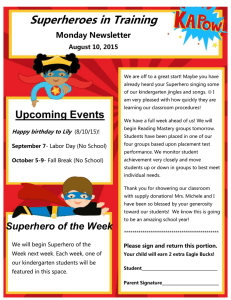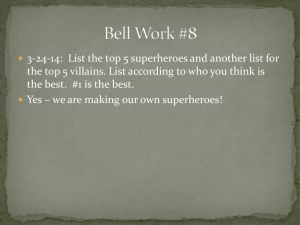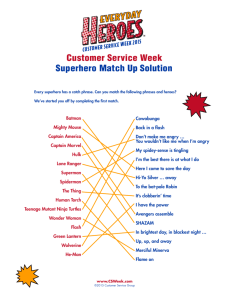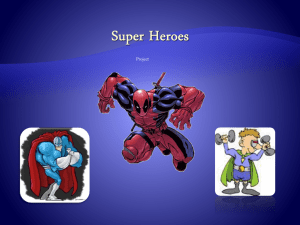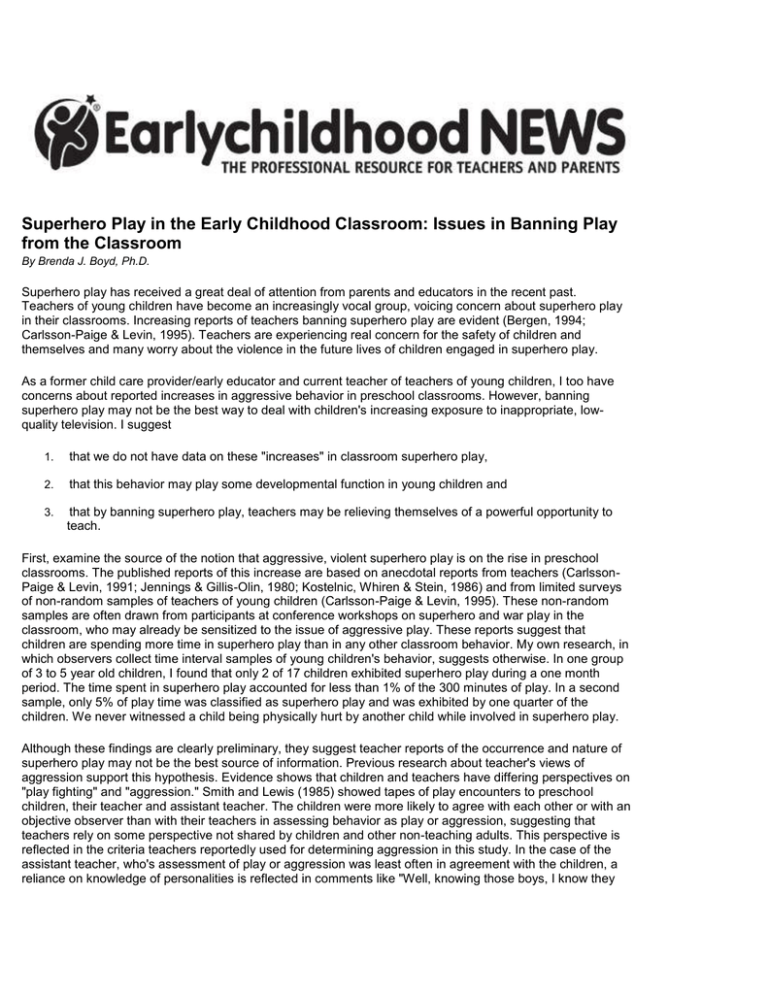
Superhero Play in the Early Childhood Classroom: Issues in Banning Play
from the Classroom
By Brenda J. Boyd, Ph.D.
Superhero play has received a great deal of attention from parents and educators in the recent past.
Teachers of young children have become an increasingly vocal group, voicing concern about superhero play
in their classrooms. Increasing reports of teachers banning superhero play are evident (Bergen, 1994;
Carlsson-Paige & Levin, 1995). Teachers are experiencing real concern for the safety of children and
themselves and many worry about the violence in the future lives of children engaged in superhero play.
As a former child care provider/early educator and current teacher of teachers of young children, I too have
concerns about reported increases in aggressive behavior in preschool classrooms. However, banning
superhero play may not be the best way to deal with children's increasing exposure to inappropriate, lowquality television. I suggest
1.
that we do not have data on these "increases" in classroom superhero play,
2.
that this behavior may play some developmental function in young children and
3.
that by banning superhero play, teachers may be relieving themselves of a powerful opportunity to
teach.
First, examine the source of the notion that aggressive, violent superhero play is on the rise in preschool
classrooms. The published reports of this increase are based on anecdotal reports from teachers (CarlssonPaige & Levin, 1991; Jennings & Gillis-Olin, 1980; Kostelnic, Whiren & Stein, 1986) and from limited surveys
of non-random samples of teachers of young children (Carlsson-Paige & Levin, 1995). These non-random
samples are often drawn from participants at conference workshops on superhero and war play in the
classroom, who may already be sensitized to the issue of aggressive play. These reports suggest that
children are spending more time in superhero play than in any other classroom behavior. My own research, in
which observers collect time interval samples of young children's behavior, suggests otherwise. In one group
of 3 to 5 year old children, I found that only 2 of 17 children exhibited superhero play during a one month
period. The time spent in superhero play accounted for less than 1% of the 300 minutes of play. In a second
sample, only 5% of play time was classified as superhero play and was exhibited by one quarter of the
children. We never witnessed a child being physically hurt by another child while involved in superhero play.
Although these findings are clearly preliminary, they suggest teacher reports of the occurrence and nature of
superhero play may not be the best source of information. Previous research about teacher's views of
aggression support this hypothesis. Evidence shows that children and teachers have differing perspectives on
"play fighting" and "aggression." Smith and Lewis (1985) showed tapes of play encounters to preschool
children, their teacher and assistant teacher. The children were more likely to agree with each other or with an
objective observer than with their teachers in assessing behavior as play or aggression, suggesting that
teachers rely on some perspective not shared by children and other non-teaching adults. This perspective is
reflected in the criteria teachers reportedly used for determining aggression in this study. In the case of the
assistant teacher, who's assessment of play or aggression was least often in agreement with the children, a
reliance on knowledge of personalities is reflected in comments like "Well, knowing those boys, I know they
can't cooperate together. Chances are it wasn't playful, it was aggressive" (Smith & Lewis, 1985, p 180).
A second line of evidence to support the hypothesis that teachers are not an objective source of information
about superhero play is available in studies that indicate teachers are more likely than non-teaching adults,
including teachers in training, to see behavior as aggressive, rather than playful. Connor (1989) showed 14
video clips of child behavior to three preschool teachers who labeled all 14 clips as aggression. When the
clips were shown to psychology students, however, only two incidents were rated as aggressive by the
majority, two were rated as play by the majority and the rest were rated differentially, depending on the
gender of the viewer. Males were more likely to view behaviors as playful while females more often labeled
behavior as aggression. The implication of these findings for young children includes an increased likelihood
of having their behavior labeled as aggression by their teachers.
The notion that superhero play may serve developmental purposes is the crux of my second concern about
the banning of superhero play. The idea that play is important for the development of young children is a
familiar one for early childhood educators. Pretend play is believed to be critical for healthy emotional
development in young children. This belief has been used to explain the importance of involvement in
superhero play (Carlsson-Paige & Levin, 1990; Curry, 1971; Ritchie, Johnson, & Zita, 1982; Slobin, 1976;
Walder, 1976). While this notion is well established in the child development literature, no empirical research
has directly examined the developmental relevance of superhero play.
However, other perspectives for investigating the function of superhero play are available. While superhero
play has not been the focus of research on the functions of play for children, "rough and tumble play" or R&T
(play fighting, wrestling and chasing behaviors of children from preschool through adolescence) has been the
focus of studies examining the function of play for children (e.g. Costabile et al, 1991; Pellegrini, 1987).
Moreover, R&T is very similar to superhero play. Both involve chasing, wrestling, kicking, mock battles and
feigned attacks (Kostelnic et al., 1986). In addition, R&T is reported to frequently involve fantasy enactment or
pretending (Smith & Connoly, 1987; Smith & Lewis, 1985). These similarities suggest that superhero play can
be conceptualized as a special case of R&T play in which children are in the role of a superhero character.
The similarity in these types of play have led to examining the functions of R&T. This body of research
suggests that R&T play may serve important developmental functions for young children, especially boys.
Specifically, three functions: affiliation, dominance and social skill facilitation have been identified as potential
functions served by R&T play (Smith & Boulton,1990).
Affiliation
R&T play may help children form or maintain friendships. The presence of laughing, smiling, and the absence
of infliction of pain (Blurton Jones, 1972; Smith, 1982) underscores the positive social nature of R&T. It has
been clearly shown that in children, R&T partners are consistently found to be friends (Humphreys & Smith,
1987; Smith & Lewis, 1985). While not direct evidence for causation of friendship by R&T play, these results
suggest that R&T play helps children develop or maintain friendships (Smith & Boulton, 1990).
Dominance
Animal researchers use the concept of dominance to discuss a literal "pecking order”. That is, a hierarchical
order of dominance and thus access to resources such as space, foods, and mates has been observed in
fowl, as well as many other species (Wilson, 1975). Moreover, this hierarchy is thought to serve the function
of reducing conflict, by making clear the power structure in a group (Hinde, 1974). Strayer and Strayer (1976)
applied this concept to a group of children, found that a fairly stable hierarchy was observable and took the
limited number of counterattacks as support for the conflict reduction hypothesis.
Smith and Boulton (1990) suggest that in R&T children are able to maintain or improve their ranking within the
hierarchy. Picking worthy "opponents" who are equal in strength would allow a child to maintain her/his rank.
A child could improve her/his rank in the safety of R&T by picking a slightly stronger play partner with little risk
involved if she/he was not successful. Humphreys and Smith (1987) report data that supports the dominance
maintenance hypothesis. When comparing class consensus rankings of the strength of 7-11 year olds, in
most cases there was no consistent difference in the two participants of a R&T bout, suggesting that children
do select partners near to them in the dominance hierarchy.
Social Skill Facilitation
R&T play may offer children an opportunity to develop social skills and consequently be more successful with
peers. Evidence supporting this hypothesis has been found in both parent-child play and peer play. It has
been reported that children whose parents (especially fathers) engage in physical play with them are more
likely to be popular with their peers (MacDonald, 1987; Parke, MacDonald, Beitel & Bhavnagri, 1987). Power
and Parke (1981) argue that physical play with parents helps children learn to regulate and interpret emotion
by serving "as context for a wide range of communicative and affectively charged social interaction" (p. 160).
Indeed in one study, physical play did correlate with girls' ability to "read" facial expression suggesting some
relationship between physical play and skill at reading social cues (Parke et al., 1987).
In terms of peer-peer R&T, the results are more numerous and more mixed. Pellegrini (1988) found that
children rejected by their peers were less successful than popular children at discriminating between serious
fighting and R&T. Additionally, for popular children, R&T was followed by rule oriented games, while for
rejected children, it led to aggression (Pellegrini, 1991). Several other researchers' findings indicate either no
relation between R&T and popularity or a negative correlation (Dodge, 1983; Ladd, 1983; Rubin, DanielsBierness & Hayvren, 1982). Comparison of these results is problematic, however, as the congruity of
definitions of R&T is unclear (Smith, 1989).
This brings us to my third and final concern about the banning of superhero play. My fear is that by simply
banning superhero play from the classroom we are giving children the message that they must hide their
interests from adults and that it is wrong to be interested in issues of power and control. Teachers may be
losing an important opportunity for influencing children's ideas about violence, the use of power and
managing individual needs in a social community. Diane Levin (1994) has published practical suggestions for
helping children to learn about establishing "peaceful" classroom communities that attend to the safety needs
of all children without simply banning superhero play. Gayle Gronlund (1992) offered interesting ideas for
moving children beyond the scripted narratives they see on television, which she developed from working with
her kindergarten class during the Ninja Turtle days. More recently Julie Greenberg (1995) discussed ways to
"make friends with the Power Rangers".
Network television programming for young children has much room for improvement. The Mighty Morphin
Power Rangers is just one example. I am not an advocate for such programming. However, as long as
children have access to such programming. Early educators must be prepared to help children deal with what
they see on television or learn about from their peers.
Brenda J. Boyd is an Assistant Professor in the Department of Human Development at Washington State
University, Pullman, WA. She teaches in the areas of child development, early education and parent-child
relationships. Her current research interests include the play of young children and the professional
development of child care providers.
References
Bergen, D. (1994). Should teachers permit or discourage violent play themes?Childhood Education, 70(5),
300-301.
Blurton Jones, N. (1972). Categories of child interaction. In Blurton Jones (Ed.), Ethological studies of child
behavior (pp. 97-129). London: Cambridge University Press.
Carlsson-Paige, N. & Levin, D.E. (1995). Can teachers resolve the war-play dilemma? Young Children, 50(5),
62-63.
Carlsson-Paige, N. & Levin, D. (1991). The subversion of healthy development and play: Teacher's reactions
to the Teenage Mutant Ninja Turtles. Day Care and Early Education, 19(2), 14-20.
Carlsson-Paige, N. & Levin, D. (1990). Who's calling the shots? How to respond effectively to children's
fascination with war play and war toys. Philadelphia, PA: New Society Publishers.
Connor, K. (1989). Aggression: Is it in the eye of the beholder? Play and Culture, 2, 213-217.
Costabile, A., Smith, P.K., Matheson, L., Aston, J., Hunter, T., & Boulton, M. (1991). Cross-national
comparison of how children distinguish serious and playful fighting. Developmental Psychology, 27, 881-887.
Curry, N.E. (1971). Five-year-old play. In N.E. Curry & S. Arnaud (Eds), Play: The child strives toward selfrealization (pp. 10-11). Washington, DC: NAEYC.
Dodge, K.A. (1983). Behavioral antecedents of peer social status. Child Development, 54, 1383-1399.
Greenberg, J. (1995). Making friends with the Power Rangers. Young Children, 50(5), 60-61.
Gronlund, G. (1992). Coping with Ninja Turtle play in my kindergarten classroom. Young Children, 48(1), 2125.
Hinde, R.A. (1974). A biological basis of human social behavior. New York: McGraw-Hill.
Humphreys, A.P., & Smith, P.K. (1987). Rough and tumble, friendship, and dominance in school children:
Evidence for continuity and change with age. Child Development, 58, 201-212.
Kostelnic, M., Whiren, A., & Stein, L. (1986). Living with He-Man: Managing superhero fantasy play. Young
Children, 41(4).
Ladd, G. (1983). Social networks of popular, average, and rejected children in a school setting. Merrill-Palmer
Quarterly, 29, 283-307.
Levin, D.E. (1992). Teaching young children in violent times: Building a peaceable classroom. Cambridge,
MA: Educators for Social Responsibility.
MacDonald, K. (1987). Parent-child physical play with rejected, neglected and popular boys. Developmental
Psychology, 23, 705-711.
Parke, R.D., MacDonald, K.B., Beitel, A., & Bhavnagri, N. (1987). The role of the family in the development of
peer relationships. In R. Peters (Ed.), Social learning and systems approaches to marriage and the family (pp.
17-44). New York: Bruner/Mazel.
Pellegrini, A. D. (1991). A longitudinal study of popular and rejected children's rough-and-tumble play. Early
Education and Development, 2(3), 205-213.
Pellegrini, A.D. (1988). Elementary-school children's rough-and-tumble play and social competence.
Developmental Psychology, 24(6), 802-806.
Pellegrini, A.D. (1987). Rough-and-tumble play: Developmental and educational significance. Educational
Psychologist, 22, 23-43.
Power, T.G., & Parke, R.D. (1981). Play as a context for early learning. In L.M. Laosa & I.E. Sigel (Eds.),
Families as learning environments for children (pp. 147-178). New York: Plenum.
Ritchie, K.E., & Johnson, Z.M. (1982, November). Superman comes to preschool: Superhero TV play. Paper
presented at the meeting of the National Association for the Education of Young Children, Washington, D.C.
Rubin, K.H., Daniels-Bierness, T., & Hayvren, M. (1982). Social and social-cognitive correlates of sociometric
status in preschool and kindergarten children. Canadian Journal of Behavioral Science, 14, 338-347.
Slobin, D. (1976). The role of play in childhood. In C. Shaefer (Ed.), Therapeutic use of child's play (pp. 95118). New York: Aronson.
Smith, P.K. (1989). The role of rough and tumble play in the development of social competence: Theoretical
perspectives and empirical evidence. In B.H. Schneider, G. Attitli, J. Nadel, & R.P Weissberg (Eds.), Social
competence in developmental perspective (pp. 239-255). London: Kluwer Academic Publishers.
Smith, P.K. (1982). Does play matter? Functional and evolutionary aspects of animal and human play. The
Behavioral and Brain Sciences, 5, 139-183.
Smith, P.K. & Boulton, M. (1990). Rough-and-tumble play, aggression, and dominance: Perceptions and
behavior in children's encounters. Human Development, 33,271-282.
Smith, P.K., & Connolly, K.J. (1987). The ecology of preschool behavior. Cambridge, England: Cambridge
University Press.
Smith, P.K., & Lewis, K. (1985). Rough-and-tumble play, fighting and chasing in nursery school children.
Ethology and Sociobiology, 6, 175-181.
Strayer, F.F., & Strayer, J. (1976). An ethological analysis of social agonism and dominance relations among
preschool children. Child Development, 47, 980-989.
Walder, R. (1976). Psychoanalytic theory of play. In C. Shaefer (Ed.), Therapeutic use of child's play (pp.7994). New York: Aronson.
Wilson, E.O. (1975). Sociobiology. The new synthesis. Cambridge, MA: Belknap Press of Harvard University
Press.
© 2006 Excelligence Learning Corporation, All Rights Reserved.

